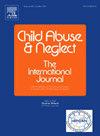Spending on public benefit programs and exposure to adverse childhood experiences
IF 3.4
2区 心理学
Q1 FAMILY STUDIES
引用次数: 0
Abstract
Background
Adverse childhood experiences are associated with poverty, and public benefit programs are increasingly used as primary prevention for negative child outcomes.
Objective
To estimate the association between spending on benefit programs and cumulative exposure to ACEs among children.
Participants and setting
Children aged 0–17 years in the United States during 2016–17 as reported in National Survey of Children's Health.
Methods
We examined the sum of state and federal spending on 5 categories of public benefit programs at the state-level. The primary exposure was mean annual spending per person living below the Federal poverty limit across 2010–2017 Federal fiscal years. The primary outcome was children <18 years old having ever been exposed to ≥ 4 ACEs.
Results
Nationally, 5.7 % (95 % confidence interval [CI] 5.3 % - 6.0 %) of children had exposure to ≥ 4 ACEs. After adjustment for children's race and ethnicity, total spending on benefit programs was associated with lower exposure to ≥ 4 ACEs (odds 0.96 [95 % CI: 0.95, 0.97]; p < 0.001). Increased spending in each individual benefit category was also associated with decreased cumulative ACEs exposure (all p < 0.05). Inverse associations were largely consistent when children were stratified by race and ethnicity and income strata.
Conclusions
Investments in public benefit programs may not only decrease poverty but also have broad positive effects on near- and long-term child well-being beyond the programs' stated objectives. Findings support federal and state efforts to prioritize families' economic stability as part of a public health model to prevent ACEs.
公共福利计划支出与童年不良经历。
背景:不良童年经历与贫困有关:儿童的不良经历与贫困有关,而公共福利项目越来越多地被用作儿童不良后果的初级预防措施:目的:估算福利计划支出与儿童累积接触 ACEs 之间的关联:根据全国儿童健康调查报告,2016-17年间美国0-17岁的儿童:我们研究了各州和联邦政府在州一级 5 类公共福利项目上的支出总和。方法:我们研究了各州和联邦在州一级 5 类公共福利项目上的支出总和。主要暴露指标是 2010 年至 2017 年联邦财政年度中生活在联邦贫困线以下的每人每年的平均支出。主要结果是儿童 结果:在全国范围内,5.7%(95% 置信区间 [CI] 5.3% - 6.0%)的儿童接触过≥ 4 种 ACE。在对儿童的种族和民族进行调整后,福利项目的总支出与儿童遭受≥ 4 次 ACEs 的几率较低有关(几率为 0.96 [95 % CI: 0.95, 0.97];P 结论:对公共福利项目的投资可能不仅会降低儿童遭受≥ 4 次 ACEs 的几率,而且还会降低儿童遭受≥ 4 次 ACEs 的几率:对公共福利计划的投资不仅可以减少贫困,还能对儿童的近期和长期福祉产生广泛的积极影响,超出计划的既定目标。研究结果支持联邦和各州在预防 ACE 的公共卫生模式中优先考虑家庭的经济稳定性。
本文章由计算机程序翻译,如有差异,请以英文原文为准。
求助全文
约1分钟内获得全文
求助全文
来源期刊

Child Abuse & Neglect
Multiple-
CiteScore
7.40
自引率
10.40%
发文量
397
期刊介绍:
Official Publication of the International Society for Prevention of Child Abuse and Neglect. Child Abuse & Neglect The International Journal, provides an international, multidisciplinary forum on all aspects of child abuse and neglect, with special emphasis on prevention and treatment; the scope extends further to all those aspects of life which either favor or hinder child development. While contributions will primarily be from the fields of psychology, psychiatry, social work, medicine, nursing, law enforcement, legislature, education, and anthropology, the Journal encourages the concerned lay individual and child-oriented advocate organizations to contribute.
 求助内容:
求助内容: 应助结果提醒方式:
应助结果提醒方式:


